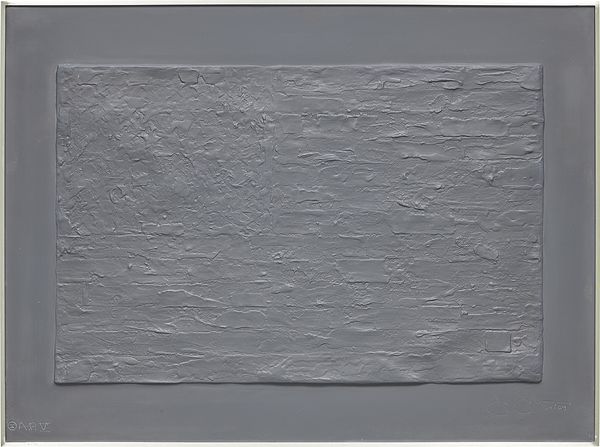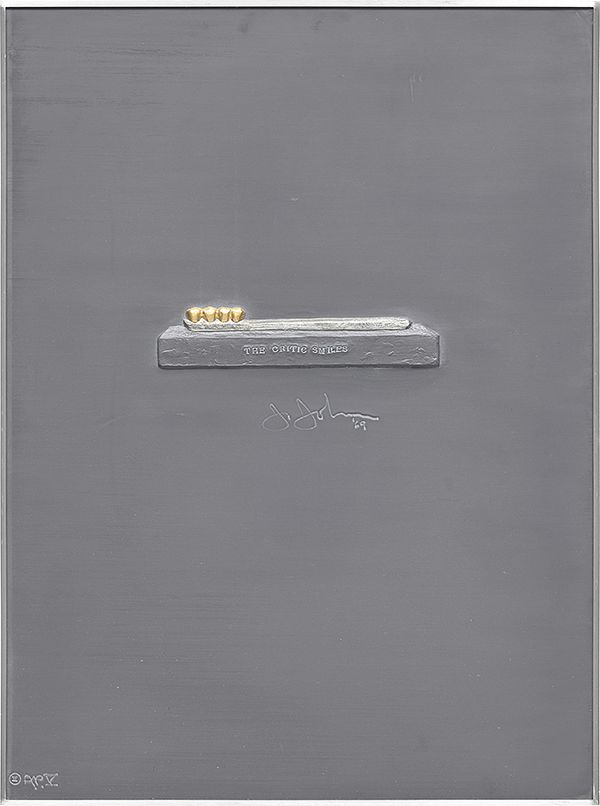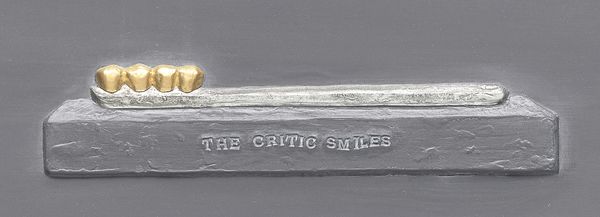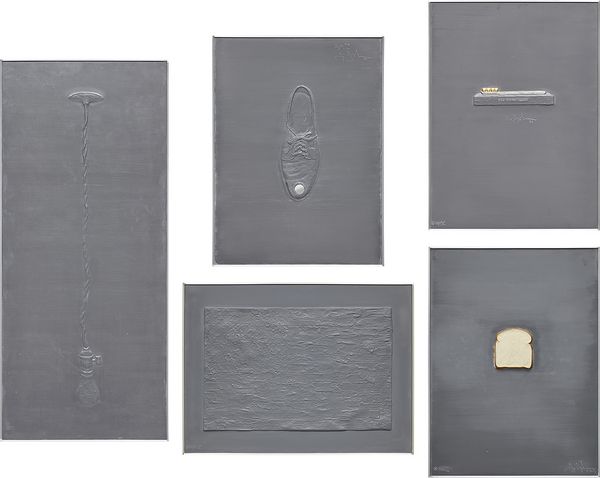Jasper Johns, Light Bulb, High School Days, The Critic Smiles, Bread, and Flag from Lead Reliefs, 1969. Editions & Works on Paper New York.
In casting a shoe, light bulb, toothbrush, flag, and a slice of bread, Jasper Johns’ Lead Reliefs series embodies the artist’s lifelong interest in de-familiarizing symbols of American culture. It is the pervasiveness of these images in our lives that empowers Johns to imbue them with conceptual contradictions, allowing what Johns refers to as “things the mind already knows” to be recontextualized. This persistent conversion of ordinary object to recurring image occurred early in Johns’ career — his iconic 1955 Flag painting is a key example. The questions posed by that work are perhaps relevant to the artist’s entire oeuvre — are we seeing an actual flag or an image of a flag? An abstracted image or a representational image? Or is it a representation of an abstract idea? This oscillation is highly characteristic of Johns’ works: images that can be understood multiple ways, each fighting for primacy in the viewer’s mind.
It is this persistence of visual and material complexity, paired with probing conceptual oppositions that sets Johns’ work apart. The artist returns to key imagery repeatedly, exploring how objects and our understanding of their ulterior meanings can change across various media. As Johns’ overall work progresses, these recurring images evolve and assume shifting identities through variation over the passage of time. He holds a curiosity of medium that has led him to employ a range of materials from encaustic and commercial house paint to lithography, intaglio, and, as we see here, lead relief.
Coming to auction for the first time as a complete set, the five works that make up Lead Reliefs are an expression of the artist’s innovative approach to materials and his consistent, ongoing reinterpretation of a culturally shared iconography.
Iconography

Jasper Johns, Flag from Lead Reliefs, 1969. Editions & Works on Paper New York.
Lead Reliefs exist in a space between the flatness of the pictorial plane and the dimensionality of sculpture. The velvety gray surface of lead is compelling for Johns. His continued fascination with depicting the American flag is seen here pushed further towards the realm of abstraction — due to the nature of the material and the absence of color.
This enigmatic image was facilitated by the production process. As stated in the Gemini G.E.L. (Graphic Editions Limited) Lead Reliefs catalogue:
“The Flag is familiar enough in his paintings, but as sculpture it originated in Sculpmetal relief (which belongs to Rauschenberg); that is, Johns modeled it in this viscous material which dries into hard metal. Later, a plaster female was taken from it; this cast was the source of an edition of four bronzes. That was it, until the lead relief based on the same original ... It also turns out that the production of the reliefs, which was experimental and innovative all the way, brought to light the fact that greater fidelity to the original was a characteristic of soft materials. One sees more details of the Flag, for example, in the embossed reliefs than the cast bronze versions.”

Jasper Johns, Light Bulb from Lead Reliefs, 1969. Editions & Works on Paper New York.
The visual lexicon of the light bulb first appears in Johns’ work in a 1957 drawing that is strikingly similar in composition to the present relief. The light bulb was further explored in an important early sculpture from 1958 that presents the object on a grandiose base — elevating the mundane to the realm of high art and echoing the ready-mades of Marcel Duchamp. The light bulb occurs repeatedly in Johns’ work as a symbol of the necessary conditions for creating and appreciating art — without light, what can we see?
So pervasive was Johns’ use of the light bulb, that it even made an appearance in popular culture. In 1999, 30 years after creating the Lead Reliefs and at a time when his work was making headlines for achieving record-breaking prices at auction, Johns made a guest voice appearance in an episode of the animated American television show The Simpsons called “Mom and Pop Art.” In the episode, Jasper Johns is shown at an art fair and is seen stealing food, shoving it into his trench coat. Before the end of that scene, he also steals a light bulb from the fair.

Jasper Johns, The Critic Smiles from Lead Reliefs, 1969. Editions & Works on Paper New York.
Both The Critic Smiles and High School Days combine Johns’ personal iconography with a unique use of materials and a striking sense of humorous wordplay. Johns, who was ever frustrated by his critics’ incapacity to understand his work and questioned the critic’s role in art culture, returned time and again to the idea of representing the critic as a toothbrush. Jasper Johns scholar Roberta Bernstein cleverly notes that the image “depicts the toothbrush with four teeth in place of the brush, creating a rebus-like translation of the object’s compound name.” High School Days further explores this rebus-like notion, with a literal mirror attached to the shoe, perhaps a reference to the so-called “mirror-shine” toecap that may have been required by Johns’ high school dress code in the American South. Or a silly homemade mechanism, one of adolescent fantasy, used to look up a girl’s skirt.

Jasper Johns, High School Days from Lead Reliefs, 1969. Editions & Works on Paper New York.
Intriguingly, the creation of Bread differs from the rest of the Lead Relief set. The bread image was cast in lead with rag paper embossed and laminated to its top surface. This casting combination was then glued onto the sheet of lead, adhered to Masonite, and finally laminated to wood. Each bread image was hand-painted in oil by the artist, and painterly flourishes are particularly evident along the crust of the impression on offer. The photorealistic slice of the American food staple drives the viewer to consider their own memories of the taste, feel, and sight of the good, while questioning the juxtaposition of the artwork’s material.

Jasper Johns, Bread from Lead Reliefs, 1969. Editions & Works on Paper New York.
Collaboration with Gemini G.E.L.
Printmaking is integral to Johns’ artmaking practice. His imaginative collaborations with eminent print workshops have produced over 360 editions, many of which are hailed as some of the most inventive works of the last century in the medium. Johns’ pioneering prints began nearly simultaneously with his early works that experimented with collage, encaustic, paint, and 3D objects. Considered together, these works represent the radical confrontation with the prevailing ideas of the time that are a hallmark of Johns’ early works. His process of returning to the same imagery repeatedly was well fit for the medium of printmaking, as was his interest in modernization. As the artist said of printmaking, “What interests me is the technical innovation possible.”
Johns accepted master printer Kenneth Tyler’s offer to collaborate on a project at Gemini G.E.L. in Los Angeles and the two embraced experimentation and innovation. Tyler once remarked, “Jasper understands process and how things work, and he understands collaboration…the artist who’s really keen about process and nuance is going to take the time to find that difference and make a note of it.”

Left: Jasper Johns, Bread from Lead Reliefs (detail), 1969. Right: Jasper Johns, High School Days (detail) from Lead Reliefs, 1969. Editions & Works on Paper New York.
Cast metal and epoxy forming molds were produced from Johns’ initial molds. Then, very soft cold-rolled sheet lead (.015 inch!) was shaped in the molds to create the relief image. Once molded in relief by means of a Hoe hydraulic embossing press, the resulting metal embossment was adhered to rigid polystyrene backings supported with wood, and then the layers of materials were encased in a welded aluminum frame. The lead surface was cleaned to allow oxidation to occur over time. In Lead Reliefs, three reliefs incorporate additional surface materials other than lead — Bread utilizes painted rag paper, High School Days has a mirror glued to the toe of the shoe, and The Critic Smiles incorporates “teeth” (cast in gold by a dentist) as well as tin leaf on the toothbrush handle.

Jasper Johns, The Critic Smiles (detail) from Lead Reliefs, 1969. Editions & Works on Paper New York.
The Lead Reliefs were a testament to Gemini G.E.L.'s innovative approach. Working tirelessly each day, the materials for a given number of pieces were driven twenty minutes away to the Amsco Corporation, where Gemini G.E.L. rented press time. Once there, Gemini G.E.L. staff would prepare the materials before a union Amsco worker would start the press. This pressing process would discolor certain areas of the lead surface, requiring a finishing treatment at Gemini G.E.L. to restore the finish of the material. Each work in the set on offer was hand-signed by the artist with an electric steel stylus, and the Gemini G.E.L. blindstamp was hand-stamped into the lead.
The Moment
Taken as a whole, the works that make up the Lead Reliefs series are representative of Jasper Johns’ indelible critique of visual culture. They encapsulate his creative obsessions with recurring imagery and his sense of curiosity and invention in process and materials.
The complete series being on offer at auction for the first time represents a unique moment for a discerning collector. It is now possible to own a set of works that showcase a nearly complete view of the unanswerable questions so poignantly representative of Jasper Johns’ artistic output. The technical innovation in the process and materials of these works is representative of Johns’ progressive approach, not only to artmaking, but to printmaking.
Discover More from Editions & Works on Paper New York >
Auction /
Editions & Works on Paper, New York
18 – 20 April 2023
Property from the Collection of Rosa and Aaron Esman, 18 April 11:00am
Evening Sale, 18 April 4:00pm
Day Sale, 19 April 11:00am & 3:00pm
Day Sale, 20 April 1:00pm
432 Park Avenue, New York (map)
Recommended Reading
